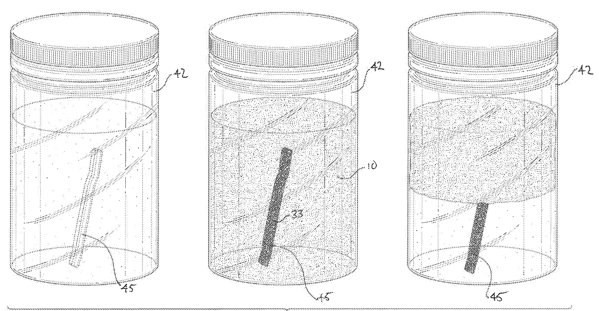| US 11,808,709 B1 | ||
| Method for testing and correcting phase separation in ethanol based fuels | ||
| Gaines Garrett, Baton Rouge, LA (US); and David Tiede, Baton Rouge, LA (US) | ||
| Assigned to MANDATORY FUEL MANAGEMENT, LLC, Baton Rouge, LA (US) | ||
| Filed by Mandatory Fuel Management, LLC, Baton Rouge, LA (US) | ||
| Filed on Mar. 13, 2020, as Appl. No. 16/817,947. | ||
| Claims priority of provisional application 62/818,386, filed on Mar. 14, 2019. | ||
| Int. Cl. G01N 21/78 (2023.08); G01N 31/22 (2023.08); G01N 33/28 (2023.08); G01N 21/75 (2006.01) | ||
| CPC G01N 21/78 (2013.01) [G01N 31/222 (2013.01); G01N 33/2847 (2013.01); G01N 2021/755 (2013.01)] | 6 Claims |

|
1. A method of testing a fuel tank and fuel within said fuel tank for phase separation and free-standing water and then treating said fuel tank and said fuel for phase separation, comprising:
a) inserting a water-detecting paste by way of a collapsible measuring stick into said fuel tank at a first opening and a second opening in order to determine if any free-standing water is present anywhere within said fuel tank or within said fuel; b) observing any color change of said water-detecting paste; c) pulling a plurality of fuel samples from said fuel tank; d) placing said fuel samples in a plurality of separate clear containers; e) placing a piece of plastic within each clear container, wherein each piece of said plastic comprises an amount of water-detecting paste; f) observing both any color change of said water-detecting paste on each piece of plastic within each container and an amount of time it takes for said water-detecting paste to change color; g) adding a chemical treatment to said fuel within said fuel tank in order to reduce or eliminate the presence of any water in suspension within said fuel and said fuel tank; h) agitating said fuel tank to evenly disperse said chemical treatment; i) allowing said fuel tank to settle; j) pulling a plurality of additional fuel samples from said fuel tank in order to re-test for phase separation with said water-detecting paste in order to determine if additional chemical treatment of said fuel is needed; and k) checking an octane rating of said fuel after said water-detecting paste indicates that no more free-standing water or water in suspension is present within said fuel and said fuel tank. |